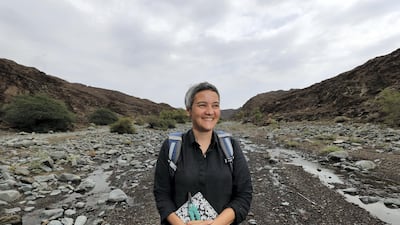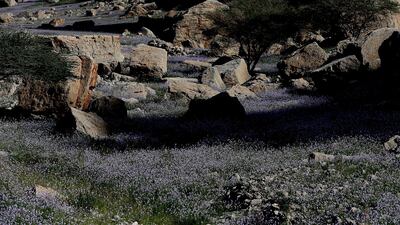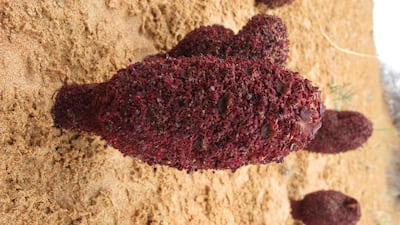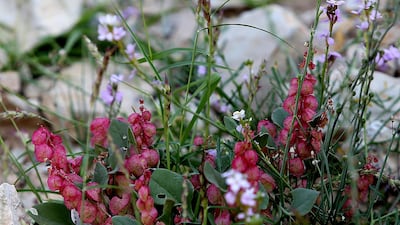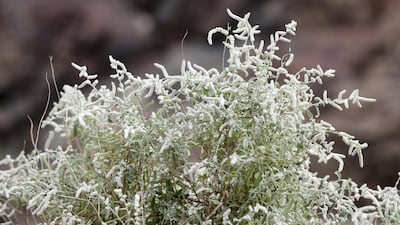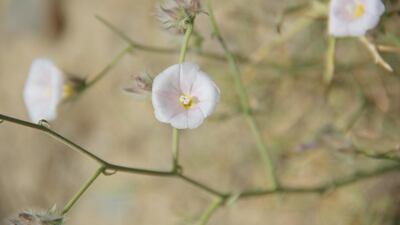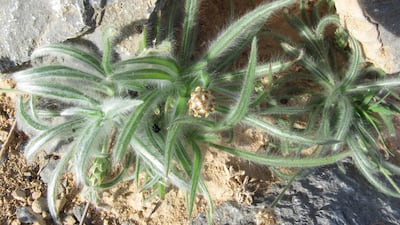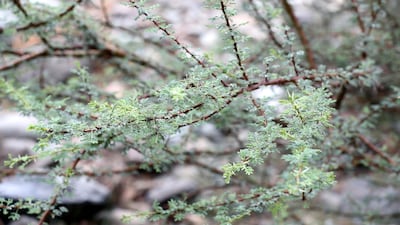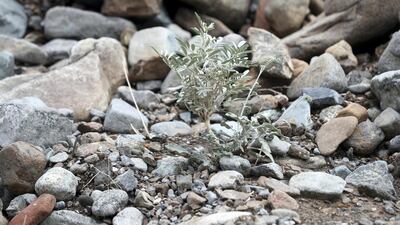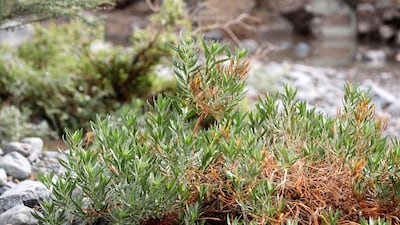Marina Tsaliki steps over a stream, that formed from the morning rain, in Wadi Showka and scans the landscape. Her eyes register a cluster of tall palms, evidence of permanent pools, and a few tumbleweeds.
“That’s usually a sign of overgrazing,” says Ms Tsaliki. “Because look, they’re all over. Grazing is always an issue, the camels and the goats.”
It is all in a day’s work for Ms Tsaliki, a soft-spoken Greek botanist for the Landscape Agency at Ras Al Khaimah Municipality’s Department of Public Works.
She is in a race against time to document the flora of Ras Al Khaimah in all its variety, from the mountain iris to fleshy, pungent desert red thumbs that attract flies with their odour.
Her survey will provide a baseline as habitats are lost to industrialisation and pushed to the brink by a changing climate.
The project began last October with a one-week survey of Jebel Jais. The agency was so impressed with her work that she was asked to expand the survey across the emirate.
Ms Tsaliki can be found roaming wadis, marshes and dunes at least three or four days a week, from sunrise to sunset.
"I sometimes just sit on a rock and look around. It is amazing what effort has been put into nature," says Ms Tsaliki, who has done similar surveys in Oman and Greece. "Glossonema varians has roots that are these funny looking thingies that turn bright pink when the fruits mature. Like, why do they do that? And these are edible, the fruits are eaten."
The plants she records flourish in one of the world’s most extreme climates. The emirate averages less than 14 centimetres of rain a year and summer temperatures can hit 50C.
Because of such extremes, plants not only change season to season but year to year. On rainy years, flowers dormant for years unfurl and cover wadi basins. Now in her second winter season. Ms Tsaliki has developed a keen eye for the remarkable.
The Emirates have comparatively few plant species for an area its size. The known species number is about 680, with around 350 in Ras Al Khaimah. But what grows is all the more remarkable for its ability to flourish in what, to the untrained eye, appears to be a barren and lifeless landscape.
Wadi Showka is particularly diverse. Ms Tsaliki surveys can find 15 to 20 different species of flora in a 100 square meter patch.
As she surveys, she speaks enthusiastically about species like Desmidorchis arabica, a "wacky, not very pretty" succulent and the joys of finding unexpected greenery cascading from cliffs. "The fern I found last week last week, I fell in love with it because it was just so tiny and it was like, ah, 'I found you.'"
Her data will identify key areas for conservation in the face of rapid residential and industrial expansion.
Development into the desert and mountains has accelerated since 2011 when the federal government increased housing grants to tens of thousands of Emiratis and invested billions in roadworks and infrastructure projects.
“Development is always good but sometimes development moves into areas that are just unique and if you have a specific habitat type in one place and once this place is used, it’s gone and so are all the plants which are there.”
Additionally, overgrazing takes a heavy toll and prehistoric aquifers are about to run dry, due largely to unsustainable agriculture practices.
Should rehabilitation be needed, Ms Tsaliki’s data will be a map of what belongs where.
The government is also collecting seeds and growing native species like Moringa peregrina and Leptadenia pyrotechnica for landscaping projects.
The Landscape Agency at the Department of Public Works has also introduced a school gardening initiative.
“We just want to get children back to nature, get their hands dirty, do a bit of digging, get to know what these plants are used for,” says Ms Tsaliki. “You don’t know you might even get someone interested in becoming a plant biologist.”
Ms Tsaliki’s own work builds on extensive documentation of the emirate’s flora by amateur botanists like Dr Marijcke Jongbloed, the former director of Sharjah Desert Park, and Gary Feulner, the chair of the Dubai Natural History Group.
The more people are involved, the more they invest as custodians of the land.
“People needed to know how to live with plants, they needed to find a balance,” says Ms Tsaliki. “Even though we’re very disconnected from all of it, there is still a very strong bond. Our clothing is cotton. Cosmetics, medicine, everything, it’s all plant based in the end.”
How native plants are used by mountain residents
Mountain residents who rely on wild vegetation expressed support for the Ras Al Khaimah Government survey of local floral.
In the Hajjar mountains, plants harvested from hills are an essential part of the medical cabinet.
Herbs are sipped in teas to boost circulation, regulate blood sugar and alleviate menstrual pain, and applied externally to heal wounds and mend broken bones.
Yet these plants are disappearing as fresh water aquifers dwindle and habitats are lost to development.
Emiratis who harvest plants raised concern that rain has decreased significantly over the last twenty years.
“Now there’s no rain like before,” said Eidam Mussabah, a resident from the hamlet of Lahzoom. “Now we’ll see years without rain.”
Ms Mussabah, 40, learnt to harvest herbs from as a child from her mother, and herbal medicine has been part of each stage of her life. When she was 40 days old, she and her mother were washed in a bath of foamy sidr leaves, a common practice for women from her region in southern Ras Al Khaimah. After she gave birth to her own daughter, she continued the custom.
But Ms Mussabah and others from the region have noticed a decline in biodiversity and quantity of vegetation.
“There’s no water,” said Sheikha Al Qaida, a honey collector from Mun’ai, a town in southern Ras Al Khaimah. “Ten years ago there were more plants because there was more rain. The wells have dried. And of course the goats are eating all the plants, too.”
So loved is rain and the lushness it brings, that earlier that day the local radio station hosted a talk show where listeners phoned in to share favourite memories of “bountiful rain”.
Ms Al Qaida makes regular treks to the mountains to harvest curative plants and honeycomb. She produces ice cream buckets filled with herbs for menstrual pains, including bitter yadah for fever and diabetes, and aloe for the heart.
When her husband broke his arm, Ms Al Qaida applied a poultice of sairayu, a type of native plant, mixed with laban.
“Before there was so much growing and much water, and it all came from the rain,” said her husband, Mohammed.
Ms Al Qaidi nodded, pointing at the boxes laid out before her. “I always have this in the house. But look, this can only grow with rain and of course, without rain even the bees will have nothing to eat.”
